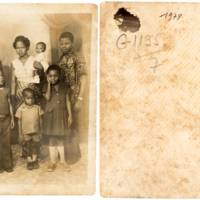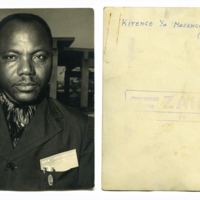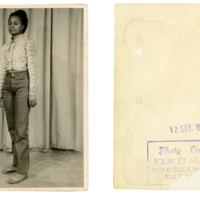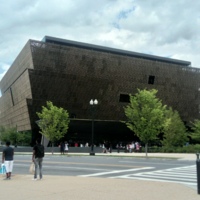
Thomas Mukambilwa
Managing Director of African Support and Project Centre Mukambilwa advocates for the improvement of Congolese lives in London through educational and health events

JJ Bola
Writer, Poet, Educator, Human. Author of No Place to Call Home. Spoken word poet turned author, Bola has read and spoken internationally at TedTalks and festivals.

Vava Tampa
Founder of Save the Congo; Activist and Rhumba lover. Tampa has been advocating for peace and justice in the Democratic Republic of Congo since 2008.

Extended Nuclear is Nuclear
Uncle and wife adopts nieces and nephews who move into the city, Kinshasa Unknown baby now deceased.

Musengwa na Makanda-Kabobi, Nsele
Title translates to Musengwa at Political Bureau Meeting Possible attendees: President Mobutu Sese Seko; Major company CEOs; Generals; Secret Services; Home Secretaries; Department Heads.

Julienne Ledi Oniumbe, Photo Luc, 1971
Daughter of Tonton Oniumbe Jules, Gecamines Employee, Lumbumbashi

National Museum of African American History and Culture
The National Museum of African American History and Culture opened in September 2016, after more than a century of development. Designed to "tell the American story through the lens of African American history and culture," it forms the only national museum in the USA that is exclusively devoted to the documentation of African American history and culture. It stands on Washington's National Mall as the newest, nineteenth museum of the Smithsonian Institute. Established by an Act of Congress in 2003, the museum has had over one million visitors since its opening.
The displays in the museum are divided into two halves. There are three history galleries, charting key events in the history of America, with specific reference to the experience of the African American community. These galleries begin with displays about Africa prior to the slave trade, showcasing the rich culture and advanced nature of civilisations there. The displays then move on to enslavement, the Middle Passage and Plantation Life. In all of these displays, the experience of the enslaved people is central to the interpretation, and much use is made of archive material, providing quotations which bring the voices of the enslaved to the fore of the narrative.
The displays in the history galleries go on to interpret abolition, reconstruction, emancipation and Civil Rights. They end with the inauguration of Barack Obama in 2009. The displays make use of a wealth of collections, some 36,000 objects now belong to the museum. The key to the narrative throughout all of these displays is the central position of African Americans to the national history of America.
The other side of the museum consists of three 'community galleries.' Again these focus on the achievements of African Americans, through themes like sport, military, theatre, television, literature and art. Here, some of the museum's 'celebrity' artefacts, including Michael Jordan's NBA finals jersey and one of Jimi Hendrix's vests. This section of the museum also houses the 'Robert Frederick Smith Explore Your Family History Centre,’ where visitors can look at digitised archive material with expert guidance to explore their own family tree.